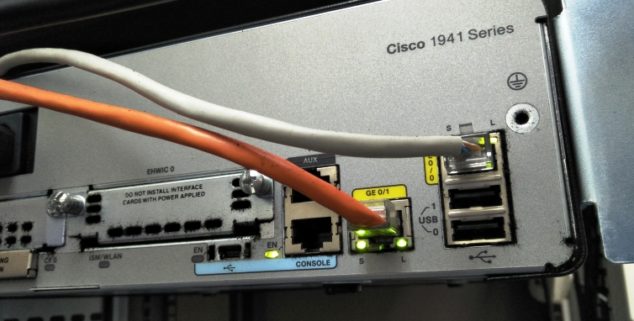Opinion
Time is now to expand Californians’ access to broadband
 A high-speed electronic hookup carrying data via an ethernet connection. (Photo: Everything You Need, via Shutterstock)
A high-speed electronic hookup carrying data via an ethernet connection. (Photo: Everything You Need, via Shutterstock)The past two years have made it abundantly clear that broadband is essential to 21st century living in California.
Broadband has become vital for education, remote work, telehealth, entertainment and family connections. It’s necessary that we prioritize finding solutions to close the digital divide that will benefit rural and urban communities.
According to a recent report by the Legislative Analyst Office (LAO), there are approximately 353,000 unserved households in California, which equates to 3% of the state’s households. The same report found that nearly 750,000 households are underserved by broadband service, representing about 6% of California’s households.
As of today, very few of the dollars in California have been allocated for last-mile broadband projects.
Fortunately, the state has set aside $6 billion in funding to help both address broadband access and affordability, including $2 billion to set up last-mile broadband connections that will connect homes and businesses.
These resources, which include funding from the federal government that will expire on Dec. 31, 2026, if not spent, present a once-in-a-generation opportunity to expand the reach of affordable, high-speed broadband services throughout the Golden State.
However, as of today, very few of the dollars in California have been allocated for last-mile broadband projects, which could leave Californians behind residents of other states that have already funded broadband deployments.
To prevent this potential disaster, California should follow the lead of other well-managed states and streamline its broadband application process and focus on connecting unserved areas and promoting public-private partnerships.\
States like Georgia have connected 83,000 rural homes and businesses to high-speed internet by partnering with Windstream.
Streamlining California’s broadband application process will maximize the funding that needs to be allocated so unserved communities can get connected to broadband. That is the goal of AB 2749, authored by Assemblywoman Sharon Quirk Silva (D-Fullerton).
The proposed bill will accelerate the deployment of critical infrastructure to California’s last remaining unserved communities. It provides strict guidelines for the California Public Utilities Commission (CPUC) to review broadband infrastructure grant applications in a timely manner so that unserved communities won’t have to wait even longer for broadband service. This is essential if the CPUC is to meet the deadlines for federal funding requirements.
In addition to streamlining its processes, states like Georgia have connected 83,000 rural homes and businesses to high-speed internet by partnering with Windstream.
In Maine, Consolidated Communications will connect 22,000 unserved homes in rural areas as part of the Connect Maine Partnership, supported by a $18 million grant.
Unfortunately, some California advocacy organizations are attempting to stall the CPUC’s broadband grant review process.
And in Amarillo, TX, Mayor Ginger Nelson announced that the city is partnering with AT&T to connect 22,000 households – the project is slated to be 70% complete within 18 months. Instead of creating their own municipal networks, these states and cities are taking the proven successful path through public-private partnerships that allow governments to control the scope of projects while benefiting from the private model of broadband deployment.
This allows governments to leverage the existing investment, innovation and expertise of private broadband providers while also freeing up dollars for pressing public needs, including public safety and repairing roads and bridges.
Unfortunately, some California advocacy organizations are attempting to stall the CPUC’s broadband grant review process because they claim that the expeditious distribution of broadband funds disadvantages Government Owned Networks (GONs).
These organizations are more concerned with supporting the creation of new GONs than getting the desperately needed, reliable infrastructure to underserved Californians. They believe that greater competition is needed in California’s broadband marketplace.
However, recent data shows that broadband prices have declined, despite high inflation. Broadband customers are getting faster speeds at lower prices due to a thriving and competitive market.
Creating new broadband networks requires skilled labor, access to fiber and materials and funding for construction, while also requiring ongoing maintenance of technically complex and dynamic networks.
In a time when the workforce labor pool is extremely low, costs are high and the country continues to be impacted by ongoing supply chain issues, it is more important than ever that states make financially sound decisions about who can build and operate broadband networks most efficiently and for the long haul.
Closing the digital divide requires a comprehensive approach that includes a sustained effort toward improving broadband adoption, while also increasing access to devices and digital literacy courses.
We can take a giant step together by ensuring that funding for broadband networks is used in the most efficient manner and work with providers with a proven track record of building resilient broadband networks, so no Californian is left behind.
—
Editor’s Note: Jonathan Spalter is the president and CEO of USTelecom-The Broadband Association.
Want to see more stories like this? Sign up for The Roundup, the free daily newsletter about California politics from the editors of Capitol Weekly. Stay up to date on the news you need to know.
Sign up below, then look for a confirmation email in your inbox.

Leave a Reply